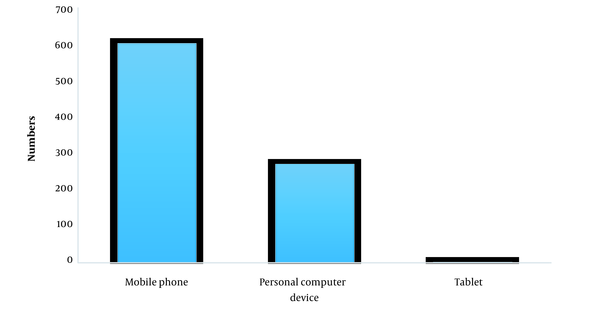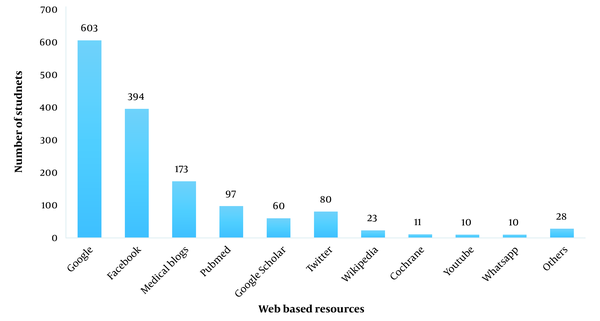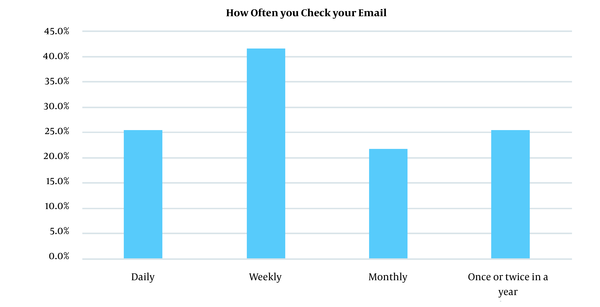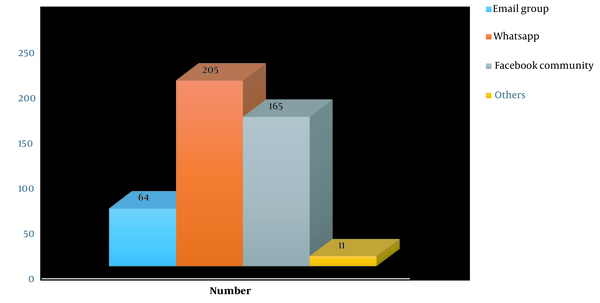Abstract
Background:
Nowadays, students have a vast knowledge of multimedia. Social media is an online platform that allows community building through collaboration.Objectives:
The present study aimed to understand the use of web-based resources for educational purposes by medical students.Methods:
This cross-sectional survey was conducted for three months on the students, interns, and residents of a tertiary care hospital and Government Medical College, Surat, India. Informed consent was taken from the participants, and a pre-approved questionnaire was delivered to all of them for data collection. The data were entered using the Google spreadsheet and were expressed using descriptive statistics.Results:
Out of the study population consisting of 900 individuals, 646 filled the questionnaires and were finally evaluated. Out of 646, 430 individuals were medical students, 335 were female, and 303 were male. The majority (91.9%) of the responders were exposed to computer education in their schools. We found that 549 (86.4%) people were aware of the free internet access provided to them in the college library. Almost 97% (617) of the responders had mobile phones with internet access, and 80.1% connected to the internet more than once a day. The results of this study showed that 94.4% of the participants accepted that they used internet-based media to enhance their academic knowledge, while 66.5% agreed that internet resources are giving much unreliable information. Moreover, 55.8% of the responders were associated with the academic e-learning groups. Only 55 (8.7%) respondents had received formal training for online literature search.Conclusions:
The emergence of various social media applications and web-based resources provides us with more collaborative approaches to medical education. However, implementing new technologies also creates new challenges and opportunities for students and faculties. Training concerning internet search and web-based resources is important to enhance their e-learning skills.Keywords
Medical Education Medical Students Social Media Web-Based Education
1. Background
The arrival of the World Wide Web in 1991 led to tremendously increased use of the internet which was soon perceived as a useful educational tool to deliver instructions (1). Before this, medical students benefited from encyclopedias for understanding various scientific terms. Nowadays, they have many websites, such as Wikipedia and Google Scholar. Standard textbooks have now been replaced by electronic versions, e-books, and smartphone applications. It is not very old when students used telephones to contact each other and plan for group studies, whereas nowadays, usually various social networks, such as WhatsApp, Telegram, and Facebook, are utilized for this aim (2). In addition to text communication, social networking applies the use of a website or an application to share information such as pictures, graphics, videos, comments, and instant messages. There are different categories of social media, including social networking sites (Facebook), blogging and microblogging (Twitter), collaborative projects (Wikipedia), virtual social worlds (Second Life), content creation (YouTube), and game zones (World of Warcraft).
With the advent of technology, learners use it more frequently as a learning tool instead of traditional learning modes (3). As quoted by Bahner et al., lectures are now podcasts, textbooks are e-books, and pharmacopeias are web-based applications (APPs) (4). Although there are differences in the technical abilities of modern and old-age medical educators, a certain level of awareness is beneficial for the educator-student relationship (4). With the continuously evolving learning styles of current-age students, it is pertinent for educators to find new ways to connect to their audience effectively. Students are now more tech-savvy than their previous generations. Therefore, it can be assumed that their understanding is also different from the previous generations. Students these days rely more and more on visual and audio multimedia images, which is one of the biggest challenges for universities and medical colleges to change their ways of delivering instructions for this net generation. The net generation, also known as generation Y (Millennials), refers to young people born during 1982 - 2000 (5). They have been exposed to the digital world from childhood, and it has become their primary source of information (6, 7). Collaboration and information sharing activities of these individuals are performed through social media for community building.
Education in all areas and fields worldwide has witnessed a shift from teacher-based curricula to student-based learning methodologies and is associated with the augmented use of information and technology, especially for communication on the web. There are various instructional techniques for education using web-based methods.
2. Objectives
The present study aimed to investigate the web-based information retrieval pattern of the students in Government Medical College. The objectives of the study are to know the awareness, usage, and purpose of web resources and to identify the facilitators and barriers to the use of web-based educational resources among medical students.
3. Methods
3.1. Study Design
This cross-sectional questionnaire-based study was conducted on medical students, interns, and residents of a tertiary care hospital affiliated with Government Medical College during December 2015- February 2016. The study was approved by Institutional Ethics Committee. The inclusion criteria entailed being the 1st-, 2nd-, or 3rd-year medical student, intern, or resident and willing to give written consent. Students who were not willing to give written consent and were not present at the institute at the time of the study were excluded from the study.
3.2. Sampling
There were a total of 900 students, interns, and residents present at the study time. All were invited to participate in the research. The objectives of the study were briefly explained to the students. They were assured that participation was voluntary and that anonymity would be maintained. After obtaining written informed consent, a paper-based questionnaire was provided to students, and 25 min was given to fill the questionnaire.
3.3. Instrument
The questionnaire was developed by reviewing the published articles containing pre-validated questionnaires. Before starting the study, the questionnaire was given to ten students to complete, and we observed that responses were consistent. There were 20 questions in the final form. The questionnaire is given in Appendix 1. It contains several questions: (1) demographic data of participant (gender, study course, medium of education), (2) schooling information of participant (private/government/both, exposure to computers at schools), (3) access to the internet (mobile phone with internet, free access to the internet at college, places of access, and how often they had access to the internet), (4) asking whether they had any formal training (internet access to medical resources, preference for internet-based resources, such as PubMed, Google Scholar, and Google, the reliability of internet sources, and if they want any training for that), and (5) educational groups (if they had e-mail addresses or not, how often they checked e-mails, whether they were a member of any academic e-learning group, such as e-mail groups, WhatsApp, and Facebook). Half of the questions were yes/no type, and other questions were multiple-choice, for some of which students could choose more than one option.
3.4. Statistical Analysis
We entered all responses in Excel sheets and analyzed the data by simple descriptive statistics (frequency and percentage) using Microsoft Excel version 2021.
4. Results
A total of 900 students were invited to participate in the survey, out of whom 646 individuals filled the questionnaires, making an overall response rate of 71.8%.
Table 1 shows the demographic details and professional qualifications of the study population. According to the results, 430 students studied MBBS, 114 were in the internship, 94 respondents were postgraduate residents, and two chose not to answer this question. Out of the responders, 303 were male, 335 were female, and two preferred not to disclose their gender. We observed that 216 had completed their school in English medium, 423 students were from vernacular media, and one had not given any information for this question.
General Characteristics of Study Participants
| Sr. No. | Characteristic | Percentage (%) |
|---|---|---|
| 1 | Gender | |
| Male | 47 | |
| Female | 53 | |
| 2 | Qualification | |
| Undergraduate medical student | 66.56 | |
| Interns | 18 | |
| Residents | 14.4 | |
| 3 | Medium of education (up to 12th standard) | |
| English | 33.85 | |
| Vernacular language (e.g., Gujarati, Hindi, others) | 66.15% |
The findings of the current study revealed that 17.7% of the respondents had graduated from a government school, 51% from a private school, and 31.1% had an education combination of both types of school before entering the Medical College. A total of 588 (91.9%) responders were exposed to computer education in their school. Out of 646 responders, 549 (86.4%) were aware of free internet provided to them in the college library, 87 (13.6%) claimed no internet access in the college library, and 4 (0.62%) were not sure about internet access in the college library. Approximately 97% (617) of responders had mobile phones with internet access. The most common place to access the internet was the college library 232 (36.6%), followed by cybercafé 74 (11.6%) and department 3 (0.5%). Patterns of devices used for accessing web resources are shown in Figure 1.
Pattern of devices used to collect information from the web (n = 646)

According to our findings, 80.1% and 12.9% of respondents connected to the internet more than once and once a day, respectively. It was demonstrated that 94.4% of the subjects accepted that they used internet-based media to enhance their academic knowledge, while 66.5% agreed that internet resources give much unreliable information. Web-based resources utilized for information seeking are displayed in Figure 2. We observed that 4.8% of responders did not have a personal e-mail with varying frequency of checking e-mail. The frequency of checking e-mails is shown in Figure 3. Furthermore, 55.8% of responders were members of academic e-learning groups, which is shown in Figure 4. Only 55 (8.7%) respondents had received formal training for online literature search. It was found that 61% of responders liked to have training/tutorial on “how to connect to the internet” for medical resources.
Web-based resources used for searching for information

Frequency of e-mail checking by the medical students

Involvement of students in academic e-learning groups

5. Discussion
Attempts were made for sharing Google form links to collect data electronically via e-mails and WhatsApp, but the response rate was very low. Consequently, questionnaires were distributed in hardcopy to improve the response rate. The response rate in our study was 71.8%. In contrast, a survey conducted among medical and dental students by Romanov and Aarnio had a response rate of 49.9% by electronic questionnaire (8). In another study by Wang et al., the electronic response rate was 61% (9). Results may show that even in today’s age of internet use, students prefer paper surveys over electronic surveys, which could be due to more familiarity and anonymity than online surveys.
Despite free internet access in college libraries and reading rooms, only 86.4% were aware of free internet access provided to them in these places. This shows ignorance in medical students about the free internet facility provided in their institute, which is very similar to the study conducted by Boruff and Storie on mobile devices in medicine. The latter authors explained that medical students and faculty regularly use mobile phones for necessary medical information and literature search without any technological and intellectual barriers. The only difficulty they face is awareness of access and the lack of reliable, library-licensed resources (10).
The findings of the current study showed that the most common place to access the internet was college library 232 (36.6%), followed by cybercafé 74 (11.6%) and department 3 (0.5%), which is lower than the study completed by Mohamed Haneefa and Jina, where 43.02%, 35.05%, and 31.96% of students used the resources of the institute, home, and cybercafé to access the web, respectively (11). Sohail and Alvi reported that 50% of students utilized cybercafé to access the internet, 8.69% in the departmental lab, and 8.69% in computer centers (12). In a study by Mohamed Haneefa and Jina, 25.8% and 13.4% of students used Google and Yahoo almost every day, respectively (11). Few students utilized Google and Yahoo two or more times a week. Another study indicated that 76.08% of students find web resources reliable, whereas 19.6% of users were not sure about the reliability of web resources (11, 12).
In our study, the most commonly used resource was Google (96%), followed by Facebook (63.1%), medical blogs (27.7%), PubMed (15.5%), Twitter (12.8%), and Google Scholar (9.6%). Google was one of the prominent web resources used in the investigations by Sohail and Alvi (57.61%) and O’Carroll et al. (76.2%) (12, 13). Giordano and Giordano found that Facebook was utilized by 91% of students (14). Although Facebook was created in 2004, it took a decade to find its way into medical education (7). It is an informal learning platform that allows experts not affiliated with a college or a school to present topics and exposes students to relevant real-world issues (15). In a study by Wang et al., the most commonly used social media were YouTube (58%) and Facebook (50%) (9).
Only 55 (8.7%) of the respondents in the current research had received formal training for online literature search. On the other hand, 80.9% of respondents received formal instructions on searching for health information in a study by O’Carroll et al. (13). Sohail and Alvi revealed that a high percentage of students (63.04%) learned using web resources from their friends (12). It was found that 61% of responders preferred to have training/tutorial on “how to access the internet” for medical resources. A meta-analysis compared different internet-based interventions and concluded that research is the best way to effectively implement the information gathered through various internet sources (1). It was observed in the present study that only 0.2% of students used Wikipedia as their source of information. This is contrary to the findings published earlier, where blogs and wikis have been reported to be the most frequently used social media for medical education. These results show the shift of medical students towards more authentic sources of information as they are being widely taught in their curriculums regarding the sources of medical information (16).
More and more students and healthcare professionals have started using social networking sites to look for educational information in the past few years. In a case study on mobile learning in resource-constrained environments, placing students and residents at the center of new learning activities affected the medical education system (17). A debate published in BMC Medical Education suggested that effectively deployed wikis, blogs, and podcasts could enhance the learning experiences of students, clinicians, and patients and deepen the engagements and collaboration of learners in digital learning environments (5).
Based on his experience, Racaniello suggested that scientists adopt social media, blogging, and podcasting to improve research and better communicate their work to the public (18). Empirical research-based evidence proving the effectiveness of technological innovation in medical education is limited. Therefore, Paton et al. reviewed the literature about using social media tools in medical and health education and concluded that social media is becoming part and parcel of how we teach and learn in the healthcare field (19). If used appropriately, some online web approaches can be included in knowledge dissemination and active engagement strategy. These days, medical educators can effectively use the interactivity of e-learning using available social media platforms. In addition, learning could be more student-centered, participatory, and collaborative with more add-on features (20).
5.1. Limitations
We exclusively assessed the students of medical backgrounds at one medical college. Therefore, the results cannot be generalized to other students. Responses were subjective, and recalling bias is possible. We have not considered any socioeconomic factors in the questionnaire which may affect the results.
5.2. Recommendations
Future studies may investigate other students at different medical colleges. In addition, students from different educational backgrounds can be involved in the study to gain a broader view of the information. Studies can be performed after giving some initial training to the students about web search, the proper way to retrieve information, as well as the validity and reliability of internet-based resources.
5.3. Conclusions
In recent years, the emergence of various social media applications and web-based resources have provided us with more collaborative approaches to medical education. New technologies also create new challenges and opportunities for students and faculties. As a result, training in internet search and web-based resources is important for enhancing e-learning skills.
References
-
1.
Cook DA, Levinson AJ, Garside S, Dupras DM, Erwin PJ, Montori VM. Internet-based learning in the health professions: a meta-analysis. JAMA. 2008;300(10):1181-96. [PubMed ID: 18780847]. https://doi.org/10.1001/jama.300.10.1181.
-
2.
Cartledge P, Miller M, Phillips B. The use of social-networking sites in medical education. Med Teach. 2013;35(10):847-57. [PubMed ID: 23841681]. https://doi.org/10.3109/0142159X.2013.804909.
-
3.
Sandars J, Morrison C. What is the Net Generation? The challenge for future medical education. Med Teach. 2007;29(2-3):85-8. [PubMed ID: 17701615]. https://doi.org/10.1080/01421590601176380.
-
4.
Bahner DP, Adkins E, Patel N, Donley C, Nagel R, Kman NE. How we use social media to supplement a novel curriculum in medical education. Med Teach. 2012;34(6):439-44. [PubMed ID: 22449268]. https://doi.org/10.3109/0142159X.2012.668245.
-
5.
Boulos MN, Maramba I, Wheeler S. Wikis, blogs and podcasts: a new generation of Web-based tools for virtual collaborative clinical practice and education. BMC Med Educ. 2006;6:41. [PubMed ID: 16911779]. [PubMed Central ID: PMC1564136]. https://doi.org/10.1186/1472-6920-6-41.
-
6.
Bennett S, Maton K, Kervin L. The ‘digital natives’ debate: A critical review of the evidence. Br J Educ Technol. 2008;39(5):775-86. https://doi.org/10.1111/j.1467-8535.2007.00793.x.
-
7.
Pander T, Pinilla S, Dimitriadis K, Fischer MR. The use of Facebook in medical education--a literature review. GMS Z Med Ausbild. 2014;31(3):Doc33. [PubMed ID: 25228935]. [PubMed Central ID: PMC4152997]. https://doi.org/10.3205/zma000925.
-
8.
Romanov K, Aarnio M. A survey of the use of electronic scientific information resources among medical and dental students. BMC Med Educ. 2006;6. [PubMed ID: 16684347]. [PubMed Central ID: PMC1479814]. https://doi.org/10.1186/1472-6920-6-28.
-
9.
Wang AT, Sandhu NP, Wittich CM, Mandrekar JN, Beckman TJ. Using social media to improve continuing medical education: a survey of course participants. Mayo Clin Proc. 2012;87(12):1162-70. [PubMed ID: 23141117]. [PubMed Central ID: PMC3541935]. https://doi.org/10.1016/j.mayocp.2012.07.024.
-
10.
Boruff JT, Storie D. Mobile devices in medicine: a survey of how medical students, residents, and faculty use smartphones and other mobile devices to find information. J Med Libr Assoc. 2014;102(1):22-30. [PubMed ID: 24415916]. [PubMed Central ID: PMC3878932]. https://doi.org/10.3163/1536-5050.102.1.006.
-
11.
Mohamed Haneefa K, Jina EM. Web-Based Information Retrieval Pattern of Medical Students. 8th International CALIBER (Convention on Automation of Libraries in Education and Research Institutions): 'Towards Building a Knowledge Society: Library as Catalyst for Knowledge Discovery and Management'. Goa University, Goa. Information and Library Network (INFLIBNET) Centre; 2011. p. 174-83.
-
12.
Sohail MD, Alvi A. Use of Web Resources by Medical ScienceStudents of Aligarh Muslim University. DESIDOC J Libr Inf Technol. 2014;34(2):125-30. https://doi.org/10.14429/djlit.34.4006.
-
13.
O'Carroll AM, Westby EP, Dooley J, Gordon KE. Information-Seeking Behaviors of Medical Students: A Cross-Sectional Web-Based Survey. JMIR Med Educ. 2015;1(1). e4. [PubMed ID: 27731842]. [PubMed Central ID: PMC5041342]. https://doi.org/10.2196/mededu.4267.
-
14.
Giordano C, Giordano C. Health professions students' use of social media. J Allied Health. 2011;40(2):78-81. [PubMed ID: 21695367].
-
15.
Cain J, Policastri A. Using Facebook as an informal learning environment. Am J Pharm Educ. 2011;75(10):207. [PubMed ID: 22345726]. [PubMed Central ID: PMC3279026]. https://doi.org/10.5688/ajpe7510207.
-
16.
Cheston CC, Flickinger TE, Chisolm MS. Social media use in medical education: a systematic review. Acad Med. 2013;88(6):893-901. [PubMed ID: 23619071]. https://doi.org/10.1097/ACM.0b013e31828ffc23.
-
17.
Pimmer C, Linxen S, Grohbiel U, Jha AK, Burg G. Mobile learning in resource-constrained environments: a case study of medical education. Med Teach. 2013;35(5):e1157-65. [PubMed ID: 23137244]. https://doi.org/10.3109/0142159X.2012.733454.
-
18.
Racaniello VR. Social media and microbiology education. PLoS Pathog. 2010;6(10). e1001095. [PubMed ID: 20975949]. [PubMed Central ID: PMC2958816]. https://doi.org/10.1371/journal.ppat.1001095.
-
19.
Paton C, Bamidis PD, Eysenbach G, Hansen M, Cabrer M. Experience in the use of social media in medical and health education. Contribution of the IMIA Social Media Working Group. Yearb Med Inform. 2011;6:21-9. [PubMed ID: 21938320].
-
20.
Larvin M. E-learning in surgical education and training. ANZ J Surg. 2009;79(3):133-7. [PubMed ID: 19317777]. https://doi.org/10.1111/j.1445-2197.2008.04828.x.
